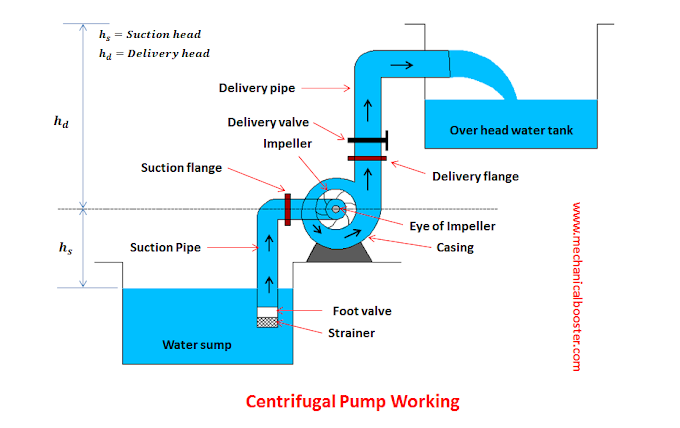Working Principle Of a Centrifugal Pump
The working
principle of a centrifugal pump is based on the transfer of mechanical
energy from a rotating impeller to the fluid being pumped. Here's a
step-by-step explanation of how a centrifugal pump operates:
1. Impeller: The pump
consists of a rotating component called the impeller. It is typically made up
of curved blades or vanes that are mounted on a central shaft.
2. Casing: The impeller is
housed within a stationary casing, which is designed to guide the fluid flow
and create pressure.
3. Inlet: The pump has an
inlet through which the fluid enters. It is typically located at the center of
the impeller.
4. Rotation: When the pump
is activated, the impeller starts to rotate rapidly, driven by a motor or an
engine. The impeller's rotation imparts kinetic energy to the fluid.
5. Centrifugal Force: As
the impeller spins, the fluid is forced towards the outer edges of the impeller
by centrifugal force. This causes the fluid to move radially outward.
6. Pressure Generation: As
the fluid moves outward, it enters the volute or diffuser section of the
casing. The volute is a gradually expanding spiral chamber that converts the
kinetic energy of the fluid into pressure energy.
7. Outlet: The pressurized
fluid exits the pump through an outlet, which is connected to the discharge
system or piping.
8. Continuous Flow: The
pump continues to rotate, creating a continuous flow of fluid. The rotation of
the impeller and the design of the casing ensure a continuous transfer of
energy to the fluid, maintaining the flow and pressure.
It's important to note that centrifugal pumps are not
self-priming, meaning they require a sufficient amount of liquid in the pump
casing to start the pumping action. If the pump loses its prime or runs dry, it
may not be able to generate sufficient pressure or flow.
Centrifugal pumps are widely used due to their simplicity,
high flow rates, and ability to handle a variety of fluids. They are commonly
used in industries such as water supply, irrigation, oil and gas, chemical
processing, and many other
A centrifugal pump is a type of pump commonly used onboard
ships, particularly in marine applications, to transport fluids such as water,
fuel, or other liquids. It works on the principle of centrifugal force to
convert mechanical energy into fluid kinetic energy.
Onboard a ship, centrifugal pumps are used for various
purposes, including:
1. Cooling Systems:
Centrifugal pumps are essential for circulating cooling water throughout the
ship's systems, such as cooling engines, generators, and other machinery. They
help maintain optimal operating temperatures and prevent overheating.
2. Bilge Pumping: Ships
require effective bilge systems to remove water, oil, or other liquids that
accumulate in the lower parts of the vessel. Centrifugal pumps are employed to
pump out the bilge water and discharge it overboard.
3. Ballast Systems: Ships
need ballast water to maintain stability and balance during loading, unloading,
and navigation. Centrifugal pumps are utilized to fill or discharge ballast
tanks, ensuring the ship remains safe and properly trimmed.
4. Firefighting Systems:
Centrifugal pumps are vital components of a ship's firefighting equipment. They
provide high-pressure water flow for fire suppression, allowing crews to tackle
onboard fires effectively.
5. Fuel Transfer: Ships
often carry large quantities of fuel for propulsion and power generation.
Centrifugal pumps are used for transferring fuel between storage tanks,
enabling efficient distribution throughout the vessel.
6. Freshwater Supply:
Centrifugal pumps are utilized to circulate freshwater within the ship's water
supply system, ensuring a constant and adequate supply for drinking, cooking,
and sanitation purposes.
Centrifugal pumps offer advantages such as high efficiency,
compact size, and relatively low maintenance requirements. They are designed to
handle different flow rates, pressures, and fluid types, making them versatile
and widely used onboard ships.






